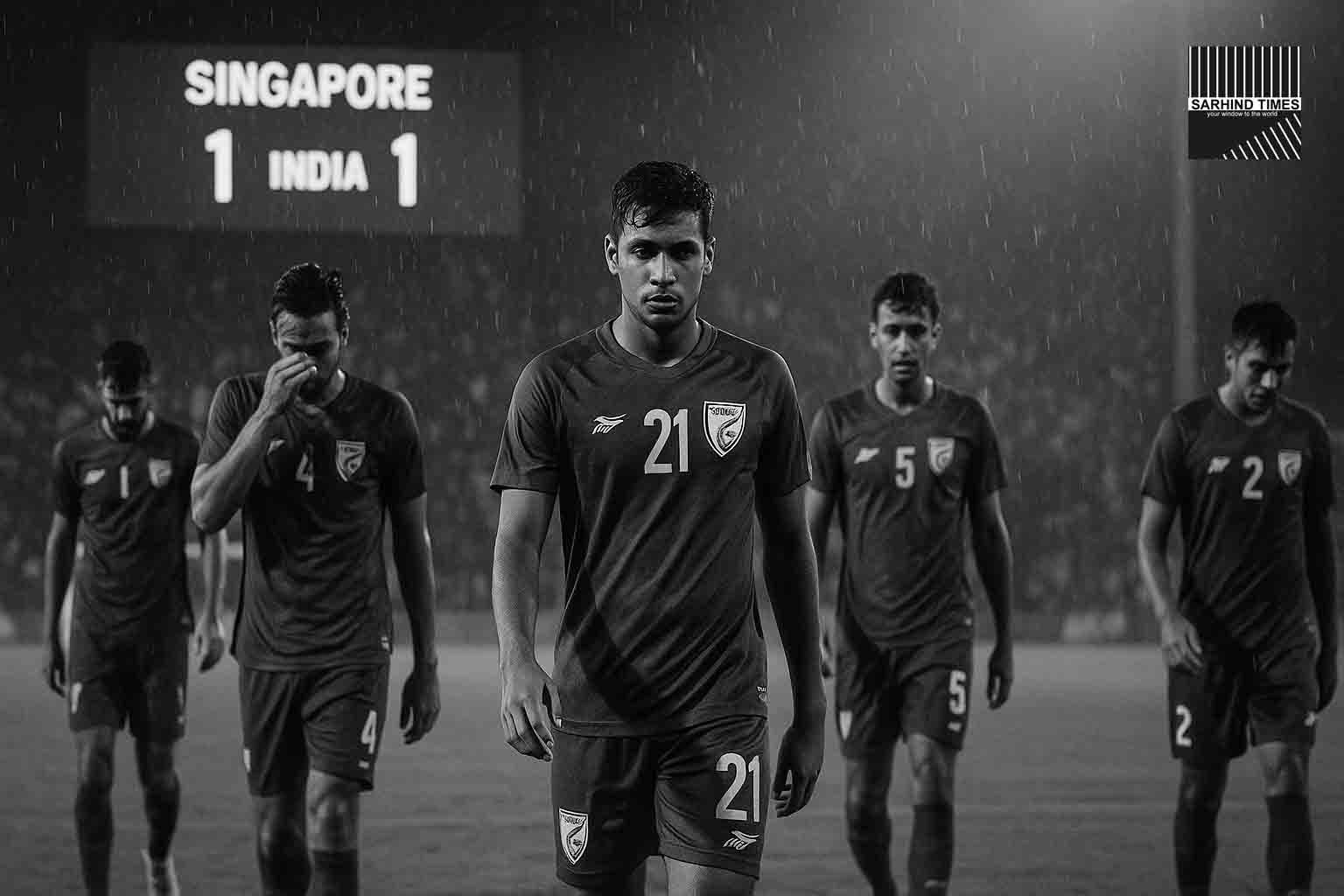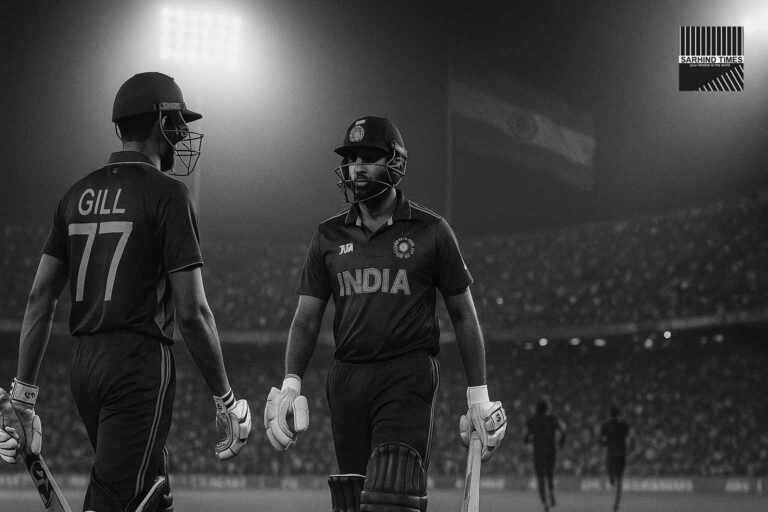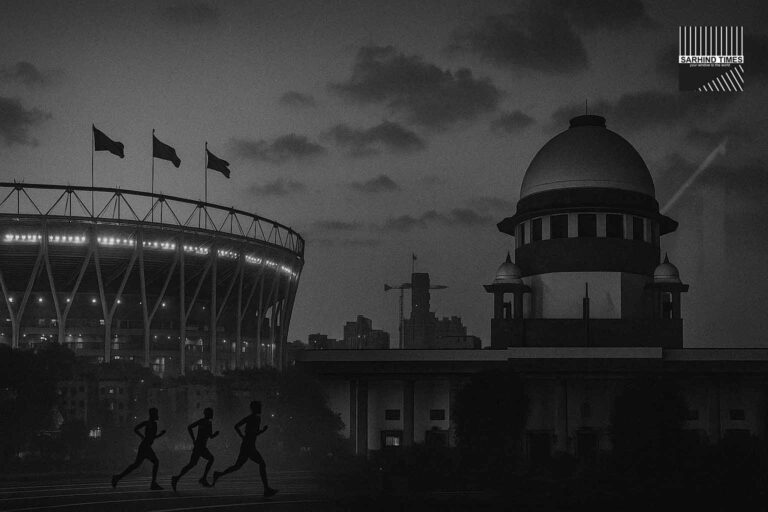Rahim Ali rescues a point for the Blue Tigers, but road to Saudi Arabia 2027 tightens after another missed opportunity in a sluggish 1–1 draw.
By SarhindTimes Sports Bureau
Singapore, October 2025
Blue Tigers Held Again — Hope Flickers, But Math Tightens
India’s campaign for AFC Asian Cup 2027 qualification suffered another setback on Tuesday night as the Blue Tigers were held 1–1 by Singapore in a match that highlighted both grit and glaring shortcomings.
Substitute Rahim Ali’s late strike salvaged a point after Singapore had taken the lead midway through the first half, but India’s inability to convert possession into purpose left them five points adrift of group leaders Jordan with just three fixtures remaining.
With only group toppers guaranteed qualification for Saudi Arabia 2027, India’s path is now precarious — reliant not just on perfect results ahead but on other teams slipping.
The Match: A Tale of Missed Chances and Late Resilience
Played in humid conditions at the Jalan Besar Stadium, the game began at a sluggish tempo, with India opting for a 4-2-3-1 shape and long spells of sterile possession.
Singapore struck first through Ikhsan Fandi, whose low drive in the 32nd minute beat goalkeeper Gurpreet Singh Sandhu at his near post. The hosts capitalized on India’s slow transitions and stretched midfield gaps, often bypassing the press with direct diagonals.
For much of the game, India looked blunt in the final third, with Manvir Singh and Lallianzuala Chhangte struggling to find rhythm. The breakthrough came only in the 78th minute when substitute Rahim Ali pounced on a rebound after a Sunil Chhetri free-kick was parried — a rare instance of India reacting quicker inside the box.
“I’m proud we didn’t give up,” said Sunil Chhetri after the match.
“But we know this draw makes things difficult. It’s still one game at a time.”
Rahim Ali: The Impact Sub
The Chennaiyin FC forward, introduced in the 70th minute, injected urgency into an otherwise predictable attack. His goal — a poacher’s finish after reacting sharply to a loose ball — was his third in international football and a reminder of India’s need for younger legs in attack.
Rahim’s pressing and off-the-ball runs unsettled Singapore’s backline, forcing errors and creating half-chances. His performance could push coach Igor Štimac to reconsider India’s attacking balance in upcoming games.
“Rahim gave us exactly what we needed — energy, aggression, and belief,”
Štimac said in the post-match presser.
“But as a team, we need to be more ruthless.”
Tactical Breakdown: The Midfield Conundrum
Analysts pointed out India’s recurring ball progression problem — an overreliance on lateral passing between defenders and holding midfielders, without vertical penetration.
Suresh Wangjam and Lalengmawia (Apuia) worked hard off the ball but offered limited creativity in possession. Without a dynamic link between midfield and attack, India’s rhythm faltered.
“India’s biggest issue isn’t effort — it’s structure,”
said Renedy Singh, former India international, on Star Sports.
“The team presses high but doesn’t recycle fast enough. We rely on moments instead of patterns.”
The absence of Anirudh Thapa, still recovering from a muscle strain, was felt. His ability to dictate tempo and distribute diagonally is something India sorely missed.
Defensive Shape: Compact but Reactive
Defensively, India held shape well for much of the first half but switched off during transitions. Singapore’s wingers found joy in the half-spaces, exploiting lapses in tracking.
Sandesh Jhingan and Anwar Ali marshalled the backline but lacked cover from midfield when Singapore overloaded centrally. Gurpreet’s misjudgment for the opening goal compounded the pressure.
“We have to defend as a unit,” Štimac said tersely.
“Individual mistakes can undo 80 minutes of discipline.”
A Group on a Knife-Edge
After this result, India sit third in Group E with 5 points from 5 games, behind Jordan (10) and Kuwait (8). Only the top team qualifies directly for the AFC Asian Cup 2027 in Saudi Arabia, while second-place teams enter the playoff round.
With upcoming fixtures against Afghanistan (home), Jordan (away), and Kuwait (home), the equation is stark:
India must win all three and hope Kuwait drops points.
“We’ve been here before — it’s not impossible, but it’s steep,” said Stephen Constantine, former India coach, in a radio interview.
“The issue is less mathematical, more mental. The team has to rediscover confidence and rhythm.”
Performance Metrics: Numbers Tell the Story
- Possession: India 59% | Singapore 41%
- Shots on Target: India 3 | Singapore 5
- Expected Goals (xG): India 0.8 | Singapore 1.2
- Pass Accuracy: India 84% | Singapore 77%
- Crosses Completed: 5 of 22 attempts
Despite territorial dominance, India’s expected goals of 0.8 highlight inefficiency — too many hopeful crosses, too few penetrative runs.
Fitness, Travel, and Scheduling Strains
The draw also reignites concerns over player fatigue and federation planning. India have played five matches in 22 days, including friendlies, with long travel stretches between Kochi, Doha, and Singapore.
“Players can’t perform optimally without proper recovery,”
said Shyam Thapa, AIFF Technical Committee member.
“We need to prioritize travel logistics and pitch quality.”
Štimac himself hinted at frustration with preparation windows, saying,
“We train hard, but we arrive at venues tired. That’s not ideal for elite football.”
Sunil Chhetri’s Reflection: “Belief Has to Stay”
At 40, Sunil Chhetri remains India’s talisman, but his words post-match carried realism.
“It’s difficult. We’re creating half-chances, not clear ones. But as long as we have games left, we fight,”
he told reporters, visibly composed but weary.
Chhetri’s leadership continues to anchor the dressing room, yet the team’s overdependence on him remains a concern.
Analysts are calling for younger strikers like Rahim Ali and Ishan Pandita to shoulder more responsibility.
Fans React: Frustration with Familiar Patterns
Social media buzzed with fan frustration over India’s recurring struggles against lower-ranked sides.
Hashtags like #BlueTigers, #AsianCupQualifiers, and #StimacOut trended overnight, with users pointing out tactical rigidity and lack of spark.
One fan’s post captured the sentiment:
“We play safe when we need courage, and we gamble when we need control.”
Despite disappointment, stadium support in Singapore remained vocal. Around 3,000 Indian fans turned up, waving tricolours and chanting “India, India” long after full time.
Analyst Corner: The Way Forward
Football analysts agree that India must rediscover attacking patterns. Possession alone won’t win matches; precision will.
Key takeaways for the next window:
- Midfield Progression: Introduce a creative playmaker to bridge defence and attack.
- Game Tempo: Increase urgency early, avoid chasing late.
- Rotation Policy: Manage Chhetri’s minutes to maximize efficiency.
- Tactical Flexibility: Press high against weaker sides, sit compact against stronger ones.
“India’s defensive block is fine, but transitions are slow,”
said Pradhyum Reddy, former assistant coach at Bengaluru FC.
“Modern football demands verticality — quick, direct link play. That’s missing.”
The Štimac Question
With India underperforming relative to expectations, speculation around Igor Štimac’s tenure has intensified.
The Croatian, who guided India to the 2023 Asian Cup finals, now faces mounting pressure to deliver a consistent qualifying run.
AIFF sources, speaking off-record, indicated the federation would review performance after the next international window.
“Results matter, but so does the football we play,” one official said.
“We want progress, not just participation.”
Editorial Insight: Between Transition and Transformation
India’s draw in Singapore encapsulates the paradox of Indian football — a team with flashes of promise but no sustained rhythm.
The structural issues remain: inconsistent domestic calendar alignment, limited exposure against higher-ranked nations, and an ongoing identity crisis between possession-based and counter-attacking football.
The result isn’t disastrous — but it’s indicative of a system that often runs in place.
If India are to make Saudi Arabia 2027, they must not just run harder, but run smarter — optimizing player workloads, nurturing midfield creativity, and embracing tactical evolution.
Fixture Outlook
| Upcoming Fixtures | Venue | Date |
| India vs Afghanistan | Kochi | Nov 15, 2025 |
| Jordan vs India | Amman | Dec 3, 2025 |
| India vs Kuwait | Kolkata | Dec 12, 2025 |
Each of these games now carries knockout intensity.
Win all three, and India could still script a comeback story. Drop even one, and qualification hopes dim.
Conclusion: Belief, But Time Running Out
As players walked off the synthetic turf at Jalan Besar, the scoreboard told a familiar tale: India 1 – 1 Singapore.
Rahim Ali’s goal gave the Blue Tigers life — but only just. The climb toward Saudi Arabia 2027 now demands perfection, resilience, and perhaps a slice of fortune.
The team’s motto for the next phase may well echo their captain’s words:
“One game at a time — but every game must be ours.”
#IndianFootball #AsianCupQualifiers #BlueTigers #RahimAli #Singapore #Chhetri #FootballIndia #SaudiArabia2027 #SportsNews #SarhindTimes

























+ There are no comments
Add yours